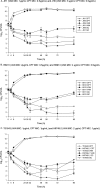Evaluation of ceftaroline activity against heteroresistant vancomycin-intermediate Staphylococcus aureus and vancomycin-intermediate methicillin-resistant S. aureus strains in an in vitro pharmacokinetic/pharmacodynamic model: exploring the "seesaw effect"
- PMID: 23545533
- PMCID: PMC3716128
- DOI: 10.1128/AAC.02308-12
Evaluation of ceftaroline activity against heteroresistant vancomycin-intermediate Staphylococcus aureus and vancomycin-intermediate methicillin-resistant S. aureus strains in an in vitro pharmacokinetic/pharmacodynamic model: exploring the "seesaw effect"
Abstract
A "seesaw effect" in methicillin-resistant Staphylococcus aureus (MRSA) has been demonstrated, whereby susceptibility to β-lactam antimicrobials increases as glyco- and lipopeptide susceptibility decreases. We investigated this effect by evaluating the activity of the anti-MRSA cephalosporin ceftaroline against isogenic pairs of MRSA strains with various susceptibilities to vancomycin in an in vitro pharmacokinetic/pharmacodynamic (PK/PD) model. The activities of ceftaroline at 600 mg every 12 h (q12h) (targeted free maximum concentration of drug in serum [fC(max)], 15.2 μg/ml; half-life [t(1/2)], 2.3 h) and vancomycin at 1 g q12h (targeted fC(max), 18 μg/ml; t(1/2), 6 h) were evaluated against 3 pairs of isogenic clinical strains of MRSA that developed increased MICs to vancomycin in patients while on therapy using a two-compartment hollow-fiber PK/PD model with a starting inoculum of ~10(7) CFU/ml over a 96-h period. Bacterial killing and development of resistance were evaluated. Expression of penicillin-binding proteins (PBPs) 2 and 4 was evaluated by reverse transcription (RT)-PCR. The achieved pharmacokinetic parameters were 98 to 119% of the targeted values. Ceftaroline and vancomycin were bactericidal against 5/6 and 1/6 strains, respectively, at 96 h. Ceftaroline was more active against the mutant strains than the parent strains, with this difference being statistically significant for 2/3 strain pairs at 96 h. The level of PBP2 expression was 4.4× higher in the vancomycin-intermediate S. aureus (VISA) strain in 1/3 pairs. The levels of PBP2 and PBP4 expression were otherwise similar between the parent and mutant strains. These data support the seesaw hypothesis that ceftaroline, like traditional β-lactams, is more active against strains that are less susceptible to vancomycin even when the ceftaroline MICs are identical. Further research to explore these unique findings is warranted.
Figures


Similar articles
-
Evaluation of ceftaroline activity versus daptomycin (DAP) against DAP-nonsusceptible methicillin-resistant Staphylococcus aureus strains in an in vitro pharmacokinetic/pharmacodynamic model.Antimicrob Agents Chemother. 2011 Jul;55(7):3522-6. doi: 10.1128/AAC.00347-11. Epub 2011 May 16. Antimicrob Agents Chemother. 2011. PMID: 21576449 Free PMC article.
-
In vitro activity of ceftaroline against methicillin-resistant Staphylococcus aureus and heterogeneous vancomycin-intermediate S. aureus in a hollow fiber model.Antimicrob Agents Chemother. 2009 Nov;53(11):4712-7. doi: 10.1128/AAC.00636-09. Epub 2009 Sep 8. Antimicrob Agents Chemother. 2009. PMID: 19738009 Free PMC article.
-
Ceftaroline increases membrane binding and enhances the activity of daptomycin against daptomycin-nonsusceptible vancomycin-intermediate Staphylococcus aureus in a pharmacokinetic/pharmacodynamic model.Antimicrob Agents Chemother. 2013 Jan;57(1):66-73. doi: 10.1128/AAC.01586-12. Epub 2012 Oct 15. Antimicrob Agents Chemother. 2013. PMID: 23070161 Free PMC article.
-
Ceftaroline fosamil: a cephalosporin with activity against methicillin-resistant Staphylococcus aureus.Clin Ther. 2012 Apr;34(4):743-65. doi: 10.1016/j.clinthera.2012.02.025. Epub 2012 Mar 22. Clin Ther. 2012. PMID: 22444785 Review.
-
Ceftaroline: a new cephalosporin with activity against resistant gram-positive pathogens.Pharmacotherapy. 2010 Apr;30(4):375-89. doi: 10.1592/phco.30.4.375. Pharmacotherapy. 2010. PMID: 20334458 Review.
Cited by
-
Missense mutations in PBP2A Affecting ceftaroline susceptibility detected in epidemic hospital-acquired methicillin-resistant Staphylococcus aureus clonotypes ST228 and ST247 in Western Switzerland archived since 1998.Antimicrob Agents Chemother. 2015 Apr;59(4):1922-30. doi: 10.1128/AAC.04068-14. Epub 2015 Jan 12. Antimicrob Agents Chemother. 2015. PMID: 25583724 Free PMC article.
-
Fosfomycin Enhances the Activity of Daptomycin against Vancomycin-Resistant Enterococci in an In Vitro Pharmacokinetic-Pharmacodynamic Model.Antimicrob Agents Chemother. 2016 Sep 23;60(10):5716-23. doi: 10.1128/AAC.00687-16. Print 2016 Oct. Antimicrob Agents Chemother. 2016. PMID: 27431211 Free PMC article.
-
Occurrence of cross-resistance and β-lactam seesaw effect in glycopeptide-, lipopeptide- and lipoglycopeptide-resistant MRSA correlates with membrane phosphatidylglycerol levels.J Antimicrob Chemother. 2020 May 1;75(5):1182-1186. doi: 10.1093/jac/dkz562. J Antimicrob Chemother. 2020. PMID: 32016379 Free PMC article.
-
Evaluation of ceftaroline, vancomycin, daptomycin, or ceftaroline plus daptomycin against daptomycin-nonsusceptible methicillin-resistant Staphylococcus aureus in an in vitro pharmacokinetic/pharmacodynamic model of simulated endocardial vegetations.Antimicrob Agents Chemother. 2014 Jun;58(6):3177-81. doi: 10.1128/AAC.00088-14. Epub 2014 Mar 24. Antimicrob Agents Chemother. 2014. PMID: 24663016 Free PMC article.
-
Mechanisms of drug resistance: daptomycin resistance.Ann N Y Acad Sci. 2015 Sep;1354:32-53. doi: 10.1111/nyas.12948. Epub 2015 Oct 23. Ann N Y Acad Sci. 2015. PMID: 26495887 Free PMC article. Review.
References
-
- Steed ME, Rybak MJ. 2010. Ceftaroline: a new cephalosporin with activity against resistant gram-positive pathogens. Pharmacotherapy 30:375–389 - PubMed
-
- Moisan H, Pruneau M, Malouin F. 2010. Binding of ceftaroline to penicillin-binding proteins of Staphylococcus aureus and Streptococcus pneumoniae. J. Antimicrob. Chemother. 65:713–716 - PubMed
Publication types
MeSH terms
Substances
Grants and funding
LinkOut - more resources
Full Text Sources
Other Literature Sources
Medical
Miscellaneous

